Smithsonian Institution Building, the Castle
Introduction
Text-to-speech Audio
Images
The Castle earns its nickname from the beautiful architectural styles, especially its unique towers. Photo by Túrelio, Wikimedia.
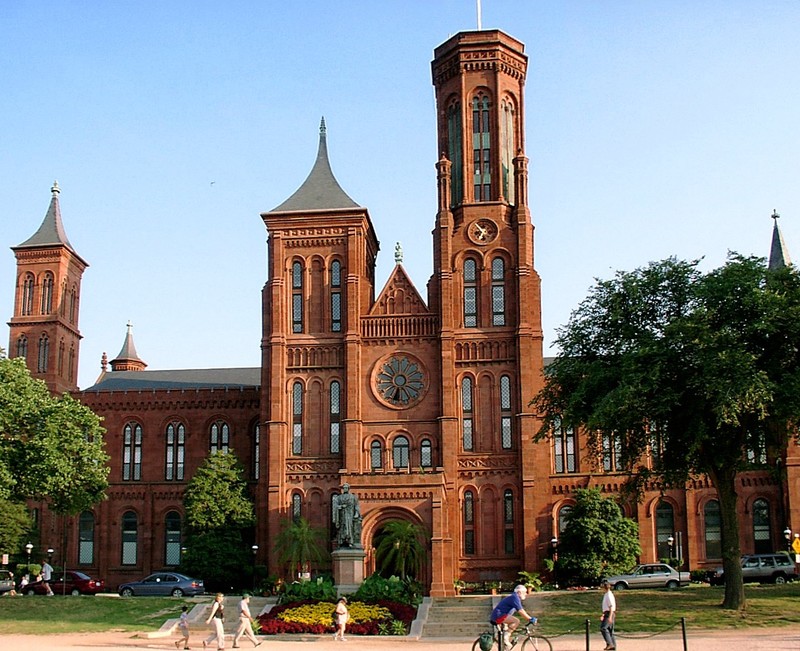
Springtime at the Castle in the Enid A. Haupt Gardens. Photo by Carol M. Highsmith, Library of Congress.
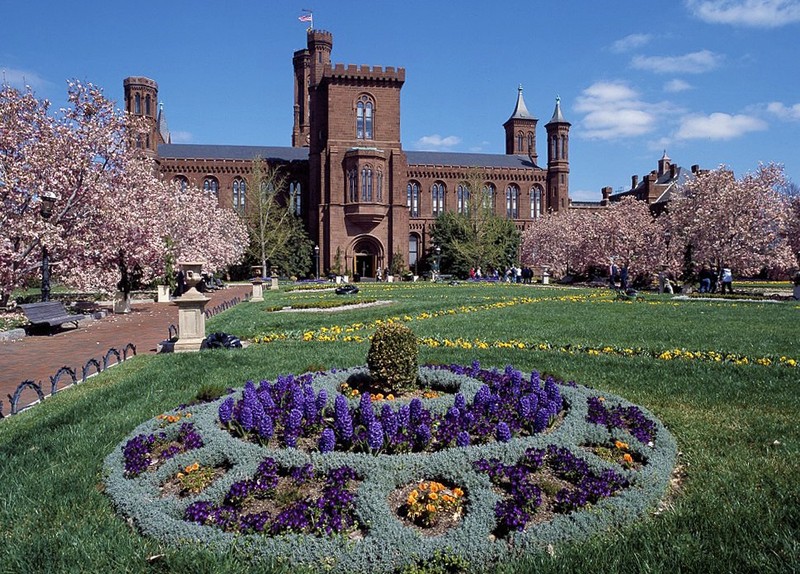
Statue of Joseph Henry, the first Secretary of the Smithsonian. Photo by David Bjorgen, Wikimedia.
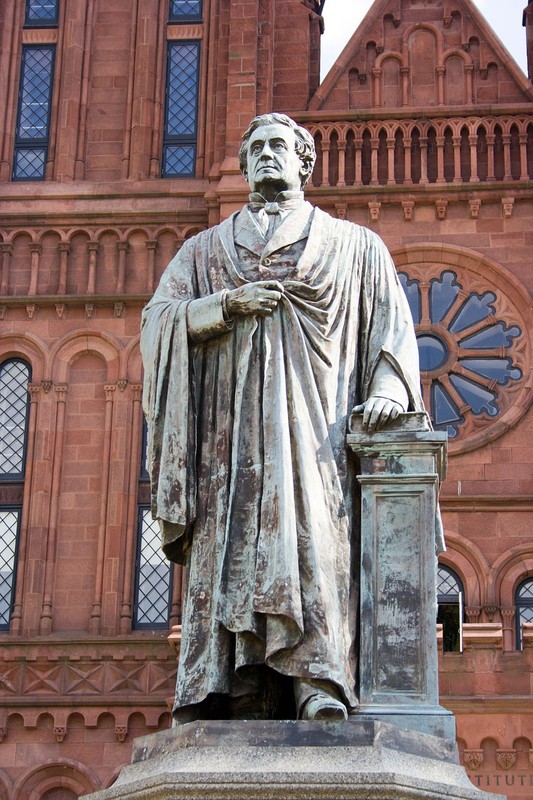
An engraving depicting the new Smithsonian Institution Building. Courtesy of the Smithsonian Institution Archives.
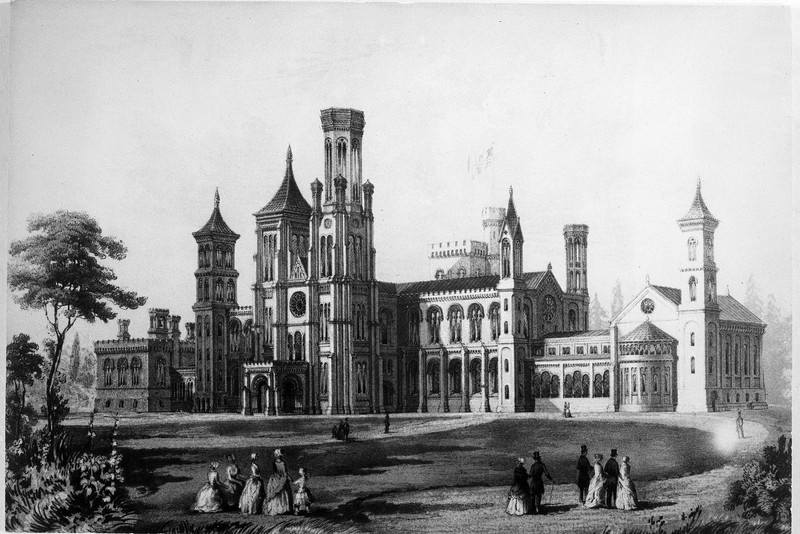
The Castle rises from the empty National Mall. A canal once separated the Castle from the picture foreground, where construction materials for the new Treasury Building rest on 15th Street, NW. Courtesy of the Smithsonian Institution Archives.
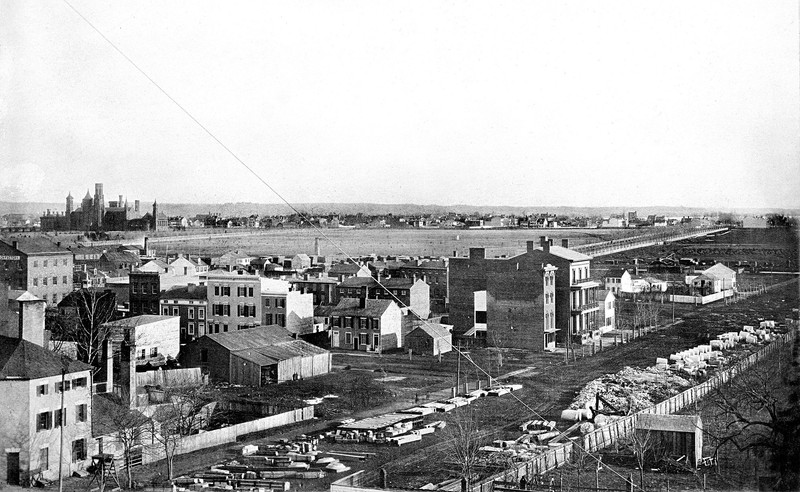
James Smithson, dressed in his Oxford regalia, gave his estate to the United States to create an institution for the "increase and diffusion of knowledge." Courtesy of the Smithsonian Institution Archives.
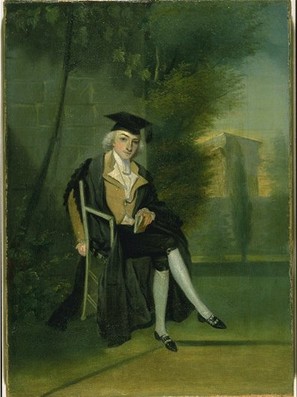
Backstory and Context
Text-to-speech Audio
In 1826, a French-born British citizen named James Smithson drafted a clause in his Last Will and Testament that would dramatically change the history of the United States and the city of Washington, D.C. Smithson had lived a successful life as a scientist who published at least 27 academic papers and was an active member of the scientific community in Europe. Despite extensive travels, Smithson had never been to the United States. Yet when Smithson died and left his estate to his nephew, the will instructed that should his nephew die without heirs, Smithson’s estate would be gifted to the United States. In 1835, after his nephew, Henry James Hungerford, died, Smithson’s estate of $500,000 was given "to the United States of America, to found at Washington, under the name of the Smithsonian Institution, an establishment for the increase and diffusion of knowledge.”1
Smithson’s gift ignited ten years of debates in Congress that not only shaped the Smithsonian Institution, but also challenged the young nation to better understand its federal authority. Congress wondered, is the United States allowed to create a national institution? The Constitution gave no such authority. Yet Federalist arguments for “increasing and diffusing knowledge” won out, and the gift was formally accepted in 1836. Congress faced yet another dilemma: what would this “Smithsonian Institution” be? They considered a university, education fund, a research institute, a national library, a publishing house, or a museum. After a decade of debate, they settled on a museum with exhibits, collections, and a library. On August 10, 1846, President James K. Polk signed the Smithsonian Institution into law, which established a Board of Regents and a Secretary to oversee the Institution and commissioned a new building within walking distance of the United States Capitol. The Smithsonian was a unique branch of the federal government in its time and it remains such today. Unlike other federal organizations, the Smithsonian controls only its buildings and grounds and is recognized as a 501(c)(3) tax-exempt educational organization.2
The Castle was designed to reflect institutions of higher learning, like those in England, and to evoke themes of the pursuit of knowledge and wisdom. Architect James Renwick Jr. designed the Castle in the Norman architectural style, a combination of late Romanesque and early Gothic motifs. The Castle is built of Seneca Redstone, a type of sandstone mined in Maryland’s Seneca Quarry. The bricks had a distinct red color caused by rusted iron in the sandstone and were also fireproof. At the time of the Castle’s construction, Seneca Quarry was owned by John Park Custis Peter, the great-grandson of George Washington’s wife. Despite its aesthetic beauty, the redstone was more than likely quarried by slaves. Scottish contractor Gilbert Cameron managed construction. Once completed in 1855, the Castle was the first building on what would become the National Mall in the late nineteenth and early twentieth century. At the time, the land was an empty, isolated swamp.3
Called the “nation’s attic,” the Castle originally housed museum collections, exhibits, administrative offices, a library, laboratories, lecture halls, and rooms for visitors to stay. Within these walls, scientists made important discoveries, visitors explored wonders of the world, speakers debated current events such as slavery and abolition, and meteorologists fostered what would become the National Weather Service. General laborers also cared for the building and its exhibits on a day-to-day basis; one of whom, Solomon Brown, was the first African American employee at the Smithsonian and served as the Institution's "eyes and ears." The first Secretary of the Smithsonian, Joseph Henry, and his family resided in the Castle’s East Wing. By the 1880s, the Smithsonian was rapidly outgrowing its space. In 1881, the Smithsonian built its first museum, now called the Arts and Industries Building. A few years later, in 1889, animals on the Castle grounds were moved to the Rock Creek area to establish the National Zoo.4
The Castle’s purpose and physical nature has changed over time. A fire destroyed large portions of the building in January 1865, when water sources to extinguish the fire were frozen. Most of James Smithson’s papers were also lost in the fire. Such devastation to the building and its resources prompted major fireproofing initiatives in the late nineteenth century. The Castle welcomed telephones in the mid-1880s and electric lighting in 1895. In 1901, the first children’s museum in Washington was installed in the South Tower Room. The exhibit halls changed as collections moved out of the Castle and into new museums lining the National Mall. In the 1960s, the Castle underwent a major renovation to include heating and air conditioning, new roofs and staircases, elevators, and a restaurant. At one time, the Castle was home to the Smithsonian Institution Archives and the Woodrow Wilson International Center for Scholars.5
Today, the Castle carries on its tradition of welcoming a diverse community of visitors and administrators. It houses an information center to orient visitors as they explore all that the Smithsonian and Washington, D.C. has to offer. Two outdoor gardens, the Enid A. Haupt Garden and Folger Rose Garden, show the beauty of nature through flowers and fountains. Exhibits inside the Castle tell the history of the Smithsonian Institution, which now comprises nineteen museums, research centers, and a zoo. These branches of the Smithsonian are historically and architecturally important in and of themselves. The Smithsonian Institution produces publications, including Smithsonian and Air & Space magazines, and also manages invaluable libraries, archives, and collections. Although the epicenter of the institution is Washington D.C., there are Smithsonian facilities in other states and countries, including Arizona, Maryland, Massachusetts, New York City, Virginia, and Panama. More than 200 other museums are considered Smithsonian Affiliates.6
One modest alcove of the Castle is also the final resting place of James Smithson. When he died in 1829, Smithson was originally buried near Genoa, Italy. Alexander Graham Bell championed the cause to bring Smithson's remains to the United States in 1904. Originally, the proposals for Smithson’s tomb - such as sprawling gardens and monuments that would have made the Lincoln Memorial look small - proved too expensive for the government at this time. Instead, the Smithsonian chose a simpler and more economical design that laid Smithson to rest in a chapel within the Castle. His sarcophagus is topped with a pine cone, representing the seeds he sowed for the “increase and diffusion of knowledge.”7
Cite This Entry
Curtin, Pamela. "Smithsonian Institution Building, the Castle." Clio: Your Guide to History. October 13, 2017. Accessed April 2, 2025. https://theclio.com/tour/48/28
Sources
1. Smithsonian Institution. “Who Was James Smithson?” Smithsonian Institution Archives; Smithsonian Institution, “James Smithson: Founder of the Smithsonian Institution,” Smithsonian Institution Archives.
2. Smithsonian Institution, “General History,” Smithsonian Institution Archives; Smithsonian Institution, “Legal History,” Smithsonian Institution Archives; Smithsonian Institution, “Legal Nature of the Smithsonian.”
3. Smithsonian Institution, “Smithsonian Institution Building, The Castle,” Smithsonian Institution Archives; Auslander, “Enslaved Labor and Building the Smithsonian,” Southern Spaces.
4. Smithsonian Institution, “Smithsonian Institution Building, The Castle,” Smithsonian Institution Archives.
5. National Park Service, "Smithsonian Institution Building," National Register of Historic Places; Smithsonian Institution, “Smithsonian Institution Building, The Castle,” Smithsonian Institution Archives.
6. Smithsonian Institution, “About,” Smithsonian Institution.
7. “Mr. Smithson Goes to Washington,” Smithsonian Preservation Quarterly.
Auslander, Mark. “Enslaved Labor and Building the Smithsonian: Reading the Stones.” Southern Spaces. December 12, 2012. Accessed October 2017. https://southernspaces.org/2012/enslaved-labor-and-building-smithsonian-reading-stones
Bisceglio, Paul. “The Story Behind Smithsonian Castle’s Red Sandstone.” Smithsonian Magazine. April 9, 2013. Accessed October 2017. https://www.smithsonianmag.com/smithsonian-institution/the-story-behind-smithsonian-castles-red-sandstone-17818600/
“Mr. Smithson Goes to Washington.” Smithsonian Preservation Quarterly. Summer/Fall 1995. pp. 4-7. https://www.si.edu/Content/ahhp/pdf/spq/Summer-Fall%201995.pdf
National Park Service. "Smithsonian Institution Building." National Register of Historic Places Inventory-Nomination Form. Washington, D.C.: National Park Service, Department of the Interior, 1969. Accessed October 2017. https://npgallery.nps.gov/pdfhost/docs/NHLS/Text/66000867.pdf
Smithsonian Institution. “About.” Smithsonian Institution. Accessed October 2017. https://www.si.edu/about
Smithsonian Institution. “General History.” Smithsonian Institution Archives. Accessed October 2017. https://siarchives.si.edu/history/general-history
Smithsonian Institution. “James Smithson: Founder of the Smithsonian Institution.” Smithsonian Institution Archives. Accessed October 2017. https://siarchives.si.edu/history/featured-topics/stories/james-smithson-founder-smithsonian-institution
Smithsonian Institution. “Legal History.” Smithsonian Institution Archives. Accessed October 2017. https://siarchives.si.edu/history/legal-history
Smithsonian Institution. “Legal Nature of the Smithsonian.” Accessed October 2017. https://www.si.edu/ogc/legalhistory
Smithsonian Institution. “Smithsonian Institution Building, The Castle.” Smithsonian Institution Archives. Accessed October 2017. https://siarchives.si.edu/history/smithsonian-institution-building-castle
Smithsonian Institution. “Solomon Brown: First African American Employee at the Smithsonian Institution.” Smithsonian Institution Archives. Accessed October 2017. https://siarchives.si.edu/history/featured-topics/stories/solomon-brown-first-african-american-employee-smithsonian-institution
Smithsonian Institution. “Who Was James Smithson?” Smithsonian Institution Archives. Accessed October 2017. https://siarchives.si.edu/history/featured-topics/smithson-smithsonian/who-was-james-smithson
Images:
“Exterior of Smithsonian Building Completed.” Engraving. 1851. Smithsonian Institution Archives. Institutional History Division. Accessed October 2017. https://siarchives.si.edu/collections/siris_sic_496
“Smithsonian Institution Building and The Mall, 1855.” Photo. 1850s. Smithsonian Institution Archives, Record Unit 95, Box 67, Folder: 2 and Record Unit 95, Box 30, Folder: 7. Accessed October 2017. https://siarchives.si.edu/collections/siris_sic_9272
“Purchase of Smithson Portrait.” Painting. 1850s. Smithsonian Institution Archives. Institutional History Division. Accessed October 2017. https://siarchives.si.edu/collections/siris_sic_313

